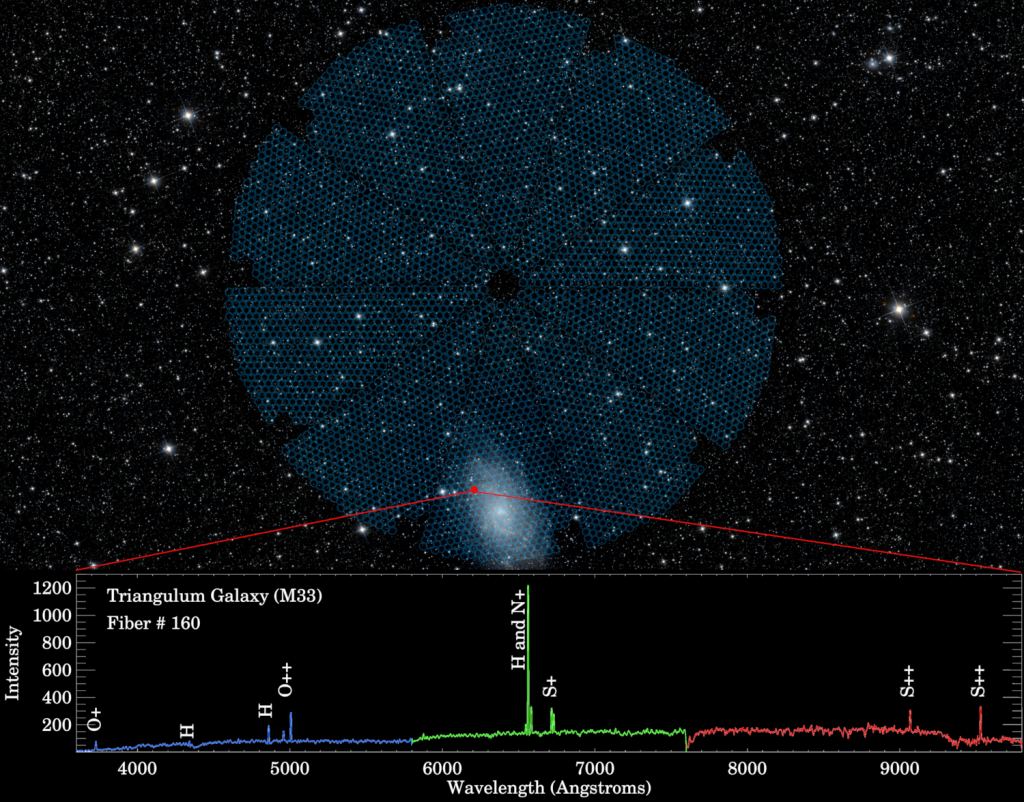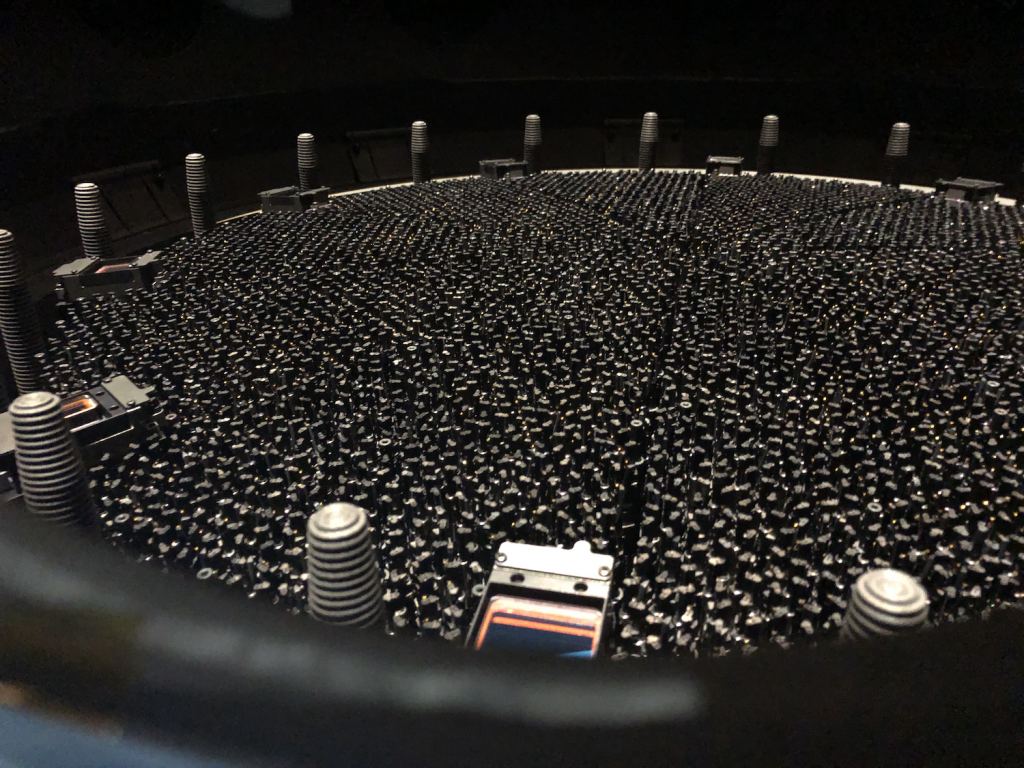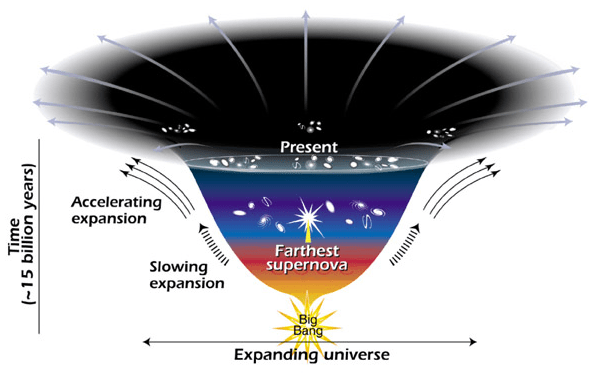Back in 2015, construction began on a new telescope called the Dark Energy Spectroscopic Instrument (DESI). Later this year, it will begin its five-year mission. Its goal? To create a 3D map of the Universe with unprecedented detail, showing the distribution of matter.
That detailed map will allow astronomers to investigate important aspects of cosmology, including dark energy and its role in the expansion of the Universe.
DESI is a collaboration between several nations: the USA, UK, France, Spain, and Mexico, with the USA’s Department of Energy Office of Science being the principal funder. Several other institutions and foundations have also contributed. DESI itself is a powerful spectrograph, and it’s being built onto the existing 4m Mayall Telescope at the Kitt Peak Observatory in Arizona.
At its heart, DESI is 5,000 individual, pencil-sized robots. Each of the 5,000 robots controls a single fiber-optic eye, and together they capture a spectra over a wavelength range from 360 nm to 980 nm. It’ll “see” from the near ultraviolet, through visible light, and into the infrared portion of the electrmagnetic spectrum.

Once it’s operating, each of DESIs 5,000 eyes will observe a single, pre-selected galaxy at a time. Under best conditions, it’ll complete a set of 5,000 galaxy observations every two minutes, before the entire telescope slews its focal plane to its next set of targets.
DESI will repeatedly map the distance to the same 35 million galaxies and 2.4 million quasars, covering about one-third of the sky in its five years of operation. By the end of its observing program, we’ll have a map of the expansion of that part of the Universe over a five year time period.
“After a decade in planning and R&D, installation and assembly, we are delighted that DESI can soon begin its quest to unravel the mystery of dark energy,” said DESI Director Michael Levi in a press release.

Years ago, the Department of Energy’s Cosmic Frontiers Program identified the need for a wide-field spectroscopy survey, and DESI will finally provide that. According to the DESI website, the new instrument will “provide new measurements that can constrain theories of modified gravity and inflation, and will provide cutting-edge limits on the sum of neutrino masses.”
DESI’s job is to analyze the light that each of its eyes gathers from a distant galaxy or quasar. The light from these galaxies was emitted a long time ago, so in a sense, DESI is looking back in time. Some of its targets are 12 billion years back in time.
“It’s a crazy, insane instrument that we’re putting together.”
Joseph Silber, Focal Plane Lead Engineer, DESI, Berkeley Lab
Imprinted on each of DESI’s targets are Baryonic Acoustic Oscillations (BAO). Those are density fluctuations in baryonic, or “normal,” matter. Those fluctuations can act as a kind of “ruler” in cosmology, similar to how standard candles are used to measure distance. But to unlock the information in those BAOs requires a detailed measurement of each target’s spectra. Those spectra can then be used to build the large 3D map of one-third of the sky, DESI’s overarching goal.
That map will reveal the story of the expansion of the Universe, which is driven by dark energy.

“Galaxies aren’t scattered randomly in space, but instead form a complex pattern from which we can learn about the composition and history of the universe.”
Professor Daniel Eisenstein of the Center for Astrophysics | Harvard & Smithsonian
“Congratulations to the DESI team of U.S. and international labs and universities in developing this amazing, state-of-the-art spectroscopic instrument,” said Kathleen Turner, DESI program manager at the Department of Energy’s Office of High Energy Physics. “We are all looking forward to using DESI’s exquisite precision to map the expansion of the universe over time.”
“This is the culmination of 10 years of hard work by an incredibly dedicated and talented team, and a major accomplishment for all involved,” said DESI Director Michael Levi.
“Galaxies aren’t scattered randomly in space, but instead form a complex pattern from which we can learn about the composition and history of the universe. The unprecedented maps from DESI will allow us to measure how the universe has expanded over time, to see how gravity and dark energy compete to pull and push material apart,” said Professor Daniel Eisenstein of the Center for Astrophysics | Harvard & Smithsonian, who serves as co-Spokesperson of the collaboration.
In March, it became clear that the coronavirus pandemic would affect DESI. The instrument’s final testing phase had to be shut down. But there was one chance to capture one last large batch of sky data, so DESI personnel went ahead with it. Then in mid-March, DESI and the Kitt Peak Observatory were shut down, to contain the spread of the novel coronavirus.
As it turns out, that last batch of test data was critical in the facility’s Critical Decision 4, a completion milestone. These test observing runs were important trial runs, and helped the operators identify any snags and troubleshoot them. On May 11th, a federal advisory board gave formal completion to the project.
Now, DESI is set to go. And after years of work, the team behind it is eager to get started.
“The early returns from the instrument were very gratifying after years of development,” said Daniel Eisenstein, a DESI spokesperson and Harvard University astronomy professor. “Now the whole team is eager to learn what DESI data will teach us about the Universe.”
The Universe can’t hide its secrets forever.

